Rendezvous with John Frawley The Real Astrology by John Frawley
Article by John Frawley
- Would you tell us a little about when, how and why you learned astrology?
J.F: I had been interested since a child, and learned to cast a chart from Margaret Hone’s textbook. What fascinated me was that astrology offered a different model of reality to what I was being taught in school. This is still what fascinates me: a coherent and flawless model of reality.
- Who has been your Guru/Teacher of Astrology; can you tell us some of your cherished moments with him/her?
J.F: My great teacher has been William Lilly. I am often regarded as a slavish adherent of his teaching, although this can be only by people who have not read my work. One great thing about Lilly is that he gets it wrong so often. This forces us to think about why and how he has gone wrong, which is a much more productive way of learning than being given words of infallibility to be slavishly memorized. Another great thing about Lilly is the way the man is so visible in the work: flawed, passionate, and endlessly engaging.
- Do you have any preferred specialisms in the field? Please tell us what they are, why you prefer it, and perhaps an example of one of your favorite applications of this type of astrology?
J.F: I retain a particular fondness for horary, because of its breathtaking simplicity.
This is a example from my Horary Textbook:
Chart: August 30th 1998, 9.20 am BST, London. Regiomontanus houses. Tropical zodiac. Asc: 9 Libra. Moon: 8 Sag.

Horary is the art of drawing specific answers to specific questions from an astrological chart set for the time the question is asked. It is quick, simple and effective, providing concrete, verifiable answers.
“How quick? How simple?”
Follow this example. You may not yet understand many of the technical terms I use, but the principle of the judgment should be clear. Next door’s cat had been gradually moving into my house. When he didn’t appear for a couple of days, I was concerned for his safety, so asked the question ‘Where is the cat?’
I set an astrological chart for the time I asked this question and for my location at that time. Printing the chart here, I have left out everything not needed for judgment.
I am asking about a cat. This is a small animal, and so is represented by the sixth house of the chart. The planet that rules the sign on the cusp of that house will signify the cat. Pisces is on the 6th cusp, so its ruler, Jupiter, signifies the cat.
Where is Jupiter? In the 6th house: the house of the cat. So where is the cat? In his own house: at home.
Is he OK? Jupiter, the most benefic of planets, is in its own sign, so has lots of essential dignity. Signified by a strongly dignified benefic, the cat is doing just fine.
Jupiter (the cat) is in a water sign, so he may be somewhere wet. But water signs also show places that are comfortable, which, considering the nature of the beast and that he is clearly happy where he is (strongly dignified benefic), must be the more likely choice. So he is probably curled up on the sofa or bed.
Will he come back? Jupiter is retrograde: it is going back where it has been before. So yes, he will come back.
The chart has given a specific, verifiable answer to the question. It has done this using only one planet! Horary is quick; horary is simple.
We can refine this answer by predicting the time of the cat’s return. For this there must be a connection between the cat’s significator and something that represents either me or my home. Jupiter is making no such contact in this chart, so we must introduce a second planet. The Moon is natural ruler of all lost objects, especially animate ones.
The person asking the question is shown by the Ascendant and its ruler. The Moon applies to sextile the Ascendant. Just as the 6th can be taken literally as the cat’s house, the first is literally my house. The Moon must travel almost exactly 1 degree to perfect this aspect. So the cat will return in almost exactly 1 unit of time. The sign and house the Moon is in as it makes this aspect tell us which unit of time this is. With the Moon in a mutable sign and a cadent house, the unit must be a day. So the cat will return almost exactly 24 hours after the time for which the chart was cast. And so it proved.
Even now, we have only two planets in the chart. Yet we have a precise, timed, accurate prediction. Horary is simple.
- How does the traditional astrology differ from the modern astrology of the west?
J.F: The important distinction is a philosophical one. The western astrological tradition is monotheistic: it is the astrology of the Christians, Jews and Moslems. As such it differs fundamentally from the astrologies of not only the modern world – although the tradition is alive and well in this modern world! – but also of the ancient Greeks, the Egyptians, and from jyotish. Despite their differences in technical approach, these astrologies have more in common with each other than they do with the western tradition.
- Can you tell us a bit more about your book Sports Astrology and its application, maybe with an example?
J.F: The problem with even the best of textbooks is that the reader cannot ask the book questions. My aim in Sports Astrology was to answer as many as possible of the puzzling questions that the student would love to ask a teacher, but cannot ask a book. Insofar as I have succeeded in that aim, the book has a far wider relevance than simply to the field of sports prediction.
Here’s a example from the book:
Chart: Sept 10th 1996, 7.08 am BST, London. Regiomontanus houses. Tropical zodiac. Asc: 23 Virgo. Moon: 17 Leo.
‘This is a horary question asked about a football match: Will we win?’
‘The querent’s favorites are shown by Mercury, Lord of the 1st. The enemy is Jupiter, Lord 7. Look! Horrible stuff happening to the 7th house: Saturn and the South Node are there.’
‘Yes. What about Mercury and Jupiter?’
‘They’re both in angular houses. But neither is in the sign of the cusp, so they’re both strong, but not that strong. Mercury is about to go back into its own sign. That must be important.’
‘Not here, my boy. If this had been a long-term question, maybe. But for a short-term issue, like the outcome of one game, we cannot cross the sign boundary.’
‘OK. So it’s retrograde: that’s weakening. And it’s opposed by this nasty Saturn.’
‘But that’s almost 4 degrees away: too far to be of great importance. Saturn afflicts Jupiter too, and more closely.’
‘Then Mercury is aspected by peregrine Mars and peregrine Venus. That must count as an affliction.’
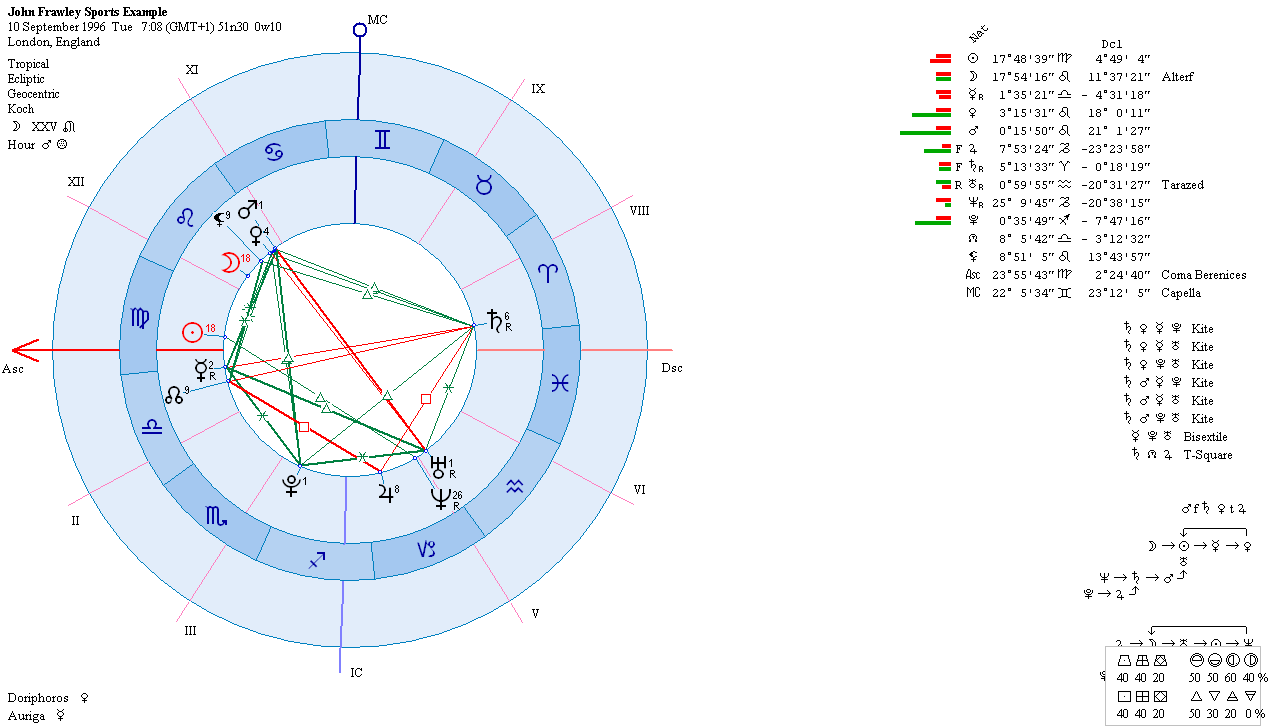
‘Good. Not such a great affliction, but certainly worth noting.’
‘That’s about it, Master. Mercury’s peregrine; Jupiter in its fall. No receptions between them. It’s all much of a muchness.’
‘Yes, from what we’ve seen so far it would be too precious to try to split them apart.’
‘So was it a draw?’
‘That would be the obvious answer – and would often be correct. But someone had to win this game. And anyway, you’re missing something.’
He thought for a moment, then, ‘It’s those little animals again, isn’t it, Master? Look, the antiscion of Jupiter is at 22.07 Sagittarius, exactly on the IC.’
‘Well spotted! Yes, by its bodily placement Jupiter is in an angle, but not so strong because it’s not in the same sign as the cusp. But by antiscion it is exactly on that angle: very powerful. There are two more testimonies here, both by antiscion. Which are…?’
‘Oh look, Saturn and the South Node afflict the 7th house bodily, but not so much because they’re not in the same sign as the cusp. But by antiscion they fall right on the Ascendant. That’s bad news for the good guys.’
‘Yes. And the third testimony?’
‘By antiscion, the North Node falls right on the 7th cusp.’
He had been doing so well, it was almost a sorrow to beat him. But it was my duty.
‘Foolish boy! The Nodes are opposite each other. If one is on the Ascendant the other will always be on the Descendant. That isn’t two testimonies; it is saying the same testimony twice. Now, where is that final testimony?’
He stared at the chart in desperation, calculating anstiscia for everything he could see, till at last he stumbled upon the right one. ‘It’s Mercury, isn’t it, Master? By antiscion it’s just inside the 7th house, in the hands of the enemy.’
‘Good! I hope you see why I set you this chart. It illustrates two very important points. First, that you cannot ignore antiscia. Here, no antiscia: no judgment. Second, it shows the difference between being in an angle in the sign of the cusp and being in an angle in a different sign to the cusp. Will you remember this?’
‘Yes, Master,’ he promised, rubbing his head.
- Do you give personal consultations, please give us an example or two of your most outstanding consultation?
J.F: Here’s another example from my Textbook. The querent’s friend was in intensive care, in a coma. After two or three days, the doctors still couldn’t work out what was wrong with her. They suspected a brain hemorrhage. What I love about this chart is, first, that the querent was not even involved in the issue: she was asking about her friend. To the modern mind, getting a accurate answer from a chart like this is crazy. Second, is that the chart provided a accurate diagnosis in a few minutes, while the doctors were unable to see what was wrong with her until the post mortem.
I stress that there is nothing clever about the astrologer here. All the astrologer needs to do is keep himself out of the way so the astrology can do its job.
Chart: July 3rd 2001, 2.18 pm BST, London. Regiomontanus houses. Tropical Zodiac. Asc: 21 Libra. Moon: 18 Sag.
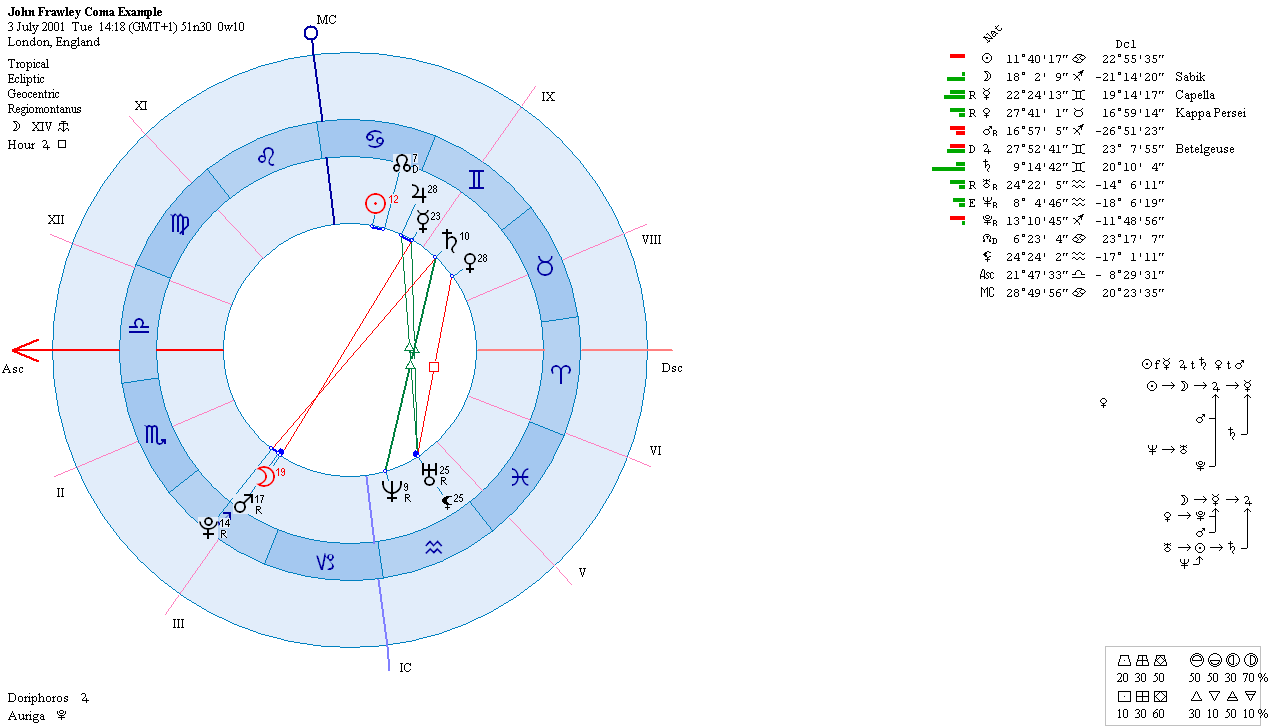
The querent said, ‘My friend has been taken to hospital. She is in a coma. The doctors don’t know what’s wrong with her, but think she may have had a brain hemorrhage. What is the problem? What is going to happen?’
The querent is not involved in this question, so we go straight to the 11th, the house of friends. Its ruler, Mercury, signifies the friend. Seeing Mercury in Gemini, we might think that the friend is doing fine. But no: although Mercury is in a sign that it rules, in a medical question it is in a very bad condition. Mercury is a cold/dry planet. It is in a hot/moist sign, a sign contrary to its nature. It is dis-eased. The friend is not well. This much we know, of course: the woman is in a coma.
Which planet is causing Mercury problems? We can look to the ruler of the sign Mercury is in. This brings us back to Mercury. There is no reason that the significator of the illness should not be the same as that of the patient. But here we have a more likely culprit, especially considering the sudden onset of the illness. Mercury is just separating from opposition to Mars. Mars is peregrine and retrograde, so it is a nasty sort of Mars.
The Moon’s most recent aspect can also be taken into account. Its last aspect was to this nasty Mars. Mars is confirmed as significator of the illness.
Mars in this part of Sagittarius, Saunders says, 40 ‘is hot and dry above nature, consuming and drying up the radical moisture and humidity of the body, and utterly extinguishing the life of man’. It does this by infecting ‘the body and blood with much thick, red choler that is hot and very dry’. Choler is the fiery humour, the fiery part of the human constitution. The doctors suspected a brain hemorrhage; had this fatal Mars been in the friend’s 1st house (the 1st being the house of the head), it could well have shown this: a kind of fiery explosion in the brain. It isn’t; it is in her 5th (the 5th house from the 11th), which is the house of the heart. She has had a heart attack. This was confirmed at the post mortem.
What will happen to her? She is in a coma, so our first question must be, ‘Will she live or will she die?’ Looking into the death of somebody other than the querent, we must consider both the turned and the radical 8th house. Here, the turned 8th house (8th from the 11th: the radical 6th) is ruled by Mars. Mercury (the friend) is separating from opposition to it. If the sick person is sitting up in bed and chatting, this is a most positive sign: she has come into contact with death; she is still alive; she is going to survive. In the context of someone in a coma it can be taken that death, in the real sense, has already happened.
The Moon separates from Mars and applies to Mercury, translating light between them and so remaking the aspect: the friend will die. The number of degrees the Moon must travel to perfect the opposition gives the timing: she will be pronounced dead at the end of that afternoon. In the blessedly small number of horaries I have been asked to judge on death in comas, this remaking of a separated aspect by translation of light is typical for showing the doctors’ recognition that hope has gone.
- How do you keep in touch with the practice of astrology today, when new significators are needed to be created for new inventions or new careers?
J.F: There are no new inventions or new careers, merely variations on old ones. There is nothing new under the Sun. If the Incarnation of Christ happened without the need for a new planet, we certainly don’t need one for some trivial invention.
- What is your most exciting or important finding, insight or discovery during your time as an astrologer?
J.F: The absolute necessity of grace. No matter how skilled we are, we cannot make two thoughts join together by our own volition: all is given to us.
- You had written about Marsilio Ficino exposition of the Part of Fortune, kindly tell our readers how you use it in your style of astrology.
J.F: Ficino writes that Love is born of Plenty and Poverty. When he writes this, it is clear that he is thinking of the Part of Fortune, which is created by the Sun (Plenty) and Moon (Poverty). So Fortua shows what we love – though in a deeper sense than romantic love. I suggest that a good name for Fortuna is the Part of Hunger. It shows what we most deeply hunger for, yearn for, long for. This makes it a great motivating force, because if we hunger so deeply for something we are likely to strive to our utmost to satisfy that hunger.
- Tetrabiblos by Ptolemy is highly regarded, can you demonstrate the effectiveness of one of its verses and how most modern astrologers have not understood its application?
J.F: I think the best of Ptolemy is his section on the Rulers of the Soul, or the Rulers of the Mind, depending on which English translation you are using. This is the ancient equivalent of sun-sign astrology, though having nothing to do with the sun-sign. But how much more valuable than sun-sign astrology! If we choose as these rulers the planet or planets with greatest influence on the Moon and Mercury, we have a quick, incisive, and very deep picture of what goes on inside the person’s psyche.
- Which prediction given by any astrologer current or past would you say was the most stunning?
J.F: The most stunning? Surely those three guys who got on their camels and travelled all the way to Bethlehem on the basis of their prediction.
- Who do you think has contributed the most to the field of astrology?
J.F: Ptolemy is by far the most influential writer. How much he deserves this influence is debatable, however.
- What do you think is the purpose of astrological knowledge?
J.F: To increase our awareness of our relationship to God.
- Which major development do you believe needs to be made to promote better understanding and application of astrology?
J.F: Reintroducing the study of logic in elementary schools. The greatest barrier to an understanding of astrology is the inability to think straight.
- What is the most unusual task you have been given to do with astrology?
J.F: How many! One that comes to mind is the woman who asked the horary question, “Will the chicken’s egg that I’m carrying around inside my bra hatch out?” I suspect you can guess what the answer was.
- Atleast once in your life you would have faced a non believer of astrology who might have attacked it mercilessly how did you react?
J.F: By changing the subject. I feel no need to persuade anyone.
- What has been your most memorable prediction till date, can you illustrate it for us so that even western astro enthusiasts can learn from your exposition.
J.F: Many predictions are memorable, for many different reasons – not only ones made in public or about public events. Especially pleasing are those where the chart forces one to look at it in a new way.
Here is an example that can be easily understood. This is taken from an article in The Astrologer’s Apprentice, issue 22.
Chart: Nov 25th 2004, 2.50 pm BST, London. Regiomontanus houses. Tropical Zodiac. Asc: 8 Taurus. Moon: 19 Taurus.

Many are they who, knowing our adherence to time-honoured methods of astrological judgment, assume that our workshop dwells in the antique glimmer of flickering tallow. Far from it, for not so distant from our yard gate is an asylum called The Twenty-first Century, the inmates of which are kept occupied producing technological bijouterie, much of which is harmless and some even useful. So it is that we have had, for several years now, an electricity supply. Ours is a green yard, so this is produced by a treadmill located in a shed next to the smithy and powered by whichever of the stable-lads have incurred our Master’s displeasure – stable-lads being an infinitely renewable source of energy.
We have become used to the easy benefits this brings, so were alarmed when the supply was suddenly cut off, plunging us into the gloom of a winter’s afternoon. Fortunately our Master, a beacon of wisdom to light even that darkness, had resisted the journeymen’s call to install computers powered by electricity, insisting that we continue to use our traditional wood-burning models. A chart was quickly set to answer the question ‘When will this power-cut end?’
Placing his substantial frame in front of the computer-screen to obscure our view, our Master demanded to know what we expected to see in this chart. Various suggestions were made, followed by a brief pause while an apprentice who had mentioned Uranus was tossed into the duck-pond. None of our answers seemed to please the Master, who now stood aside to let us judge the chart.
Every attempt was answered with a shake of the Master’s head, until all our explanations were exhausted. ‘What do we want?’ he asked us. We stared at him, dumbfounded, until by poking and prodding he forced the answer from us: we wanted the lights to come back on. ‘So where in the chart do we see lights about to come on?’
It was Jeremiah, a recently qualified craftsman astrologer, who spotted the testimony: the Moon was about to rise! The Master beamed. ‘Yes, the Moon is the natural significator of artificial light, shining as it does with borrowed light. By primary motion it is soon to come over the horizon, making itself visible. 11 degrees of a fixed sign: the lights will come on in 11 hours.’
Jeremiah, inflated by his success, dared to differ. ‘No,’ he said. ‘We’re an up-to-date yard. It’s only a loose connection, same as always. 11 minutes.’ Secure in the knowledge that the chart would prove him right, the Master kept silent. There was no loose connection, but a serious breakage in the treadmill itself. Robin, our smith, set to work immediately. Power was restored 11 hours later.
Although we are usually concerned only with the secondary motion of the planets against the backdrop of the signs, a motion that appears as anticlockwise in our charts, the primary motion that is the reflection of the Earth’s daily rotation, taking planets from the Ascendant to the Midheaven and down to the Descendant, must not be forgotten. It is especially significant in Return charts, but has its part to play in horary. In any chart concerned with death, for example, a significator near the Descendant and therefore setting by primary motion is a major testimony.
- Which has been the toughest chart that you faced till date & why, can you illustrate it here for us & what were your predictions on it.
J.F: Mundane astrology is always hard work. There are so many charts involved, of all the various cycles of time. A particularly difficult one was when a government had been advised by its scientists that it might expect an earthquake on a certain date. I was asked to check this out. The charts showed a good deal of evidence supporting the idea. The problem is, though, that while one can study charts for when earthquakes have happened, one cannot possibly study charts for all the occasions when earthquakes have not happened. So we cannot know how much evidence we need in order to predict an earthquake.
I advised erring on the side of caution by keeping the emergency services on stand-by, but fortunately nothing happened.
- Can you illustrate any of your worst failures in astrological prediction and your afterthought on it?
J.F: In a lecture, I predicted that Denmark would win the Eurovision Song Contest, which was to be held a few days later. Out of 24 competitors, Denmark came 23rd. My afterthought? OK, I got it wrong.
- What are the qualities that make one a good astrologer and what is that one quality that you prescribe most?
J.F: Clear thinking to read the chart and, God willing, a certain amount of compassion with which to communicate what one has read.
- If you were to cast a horary chart for USA Economy now as to what do you see in the coming years, what would be your predictions based on your astrological analysis. An illustration would be most helpful.
J.F: Horaries I have done for clients suggest a period of difficulty lasting several years. But their questions have had the state of the economy only as background to their personal concerns. Casting a chart specifically for the broad mundane issue is most unlikely to produce a judgment of any value, because unless the astrologer is very close to the seat of power he is most unlikely to be able to see beyond his own preconceptions. Even if he is close to the seat of power he will find this difficult, because those sitting in that seat are similarly unable to see beyond their own preconceptions.
Sounder judgment can be gained from study of the mundane charts, because we can compare what is happening now with what the stars were doing at similar times in the past. We can skip the insoluble question of which is the ‘correct’ chart for the USA by using the chart for the great conjunction before independence. As I’ve demonstrated in issue 19 of The Astrologer’s Apprentice this works very well. March 18 1762, 4.41 pm GMT. It makes sense to cast this for Washington, even though Washington was no more than a patch of swamp at that time.
- Some have called you the reincarnation of William Lilly the 17th century astrologer due to your dismissal of modern western astrology practices, how do you face these criticisms and what’s your reply to your critics.
J.F: I don’t reply to my critics. I do the work that’s mine to do: take it or leave it.
- Did you ever experience a Vedic Astrology reading from an Indian, if so what was your impression of it?
J.F: I had an interesting experience when an Indian newspaper in England sent someone to interview me. He turned out to be a gold medalist in jyotish, who returned a few days later with some prashnas that he had judged. I set charts for the same time and place, judging them by western horary methods. Different zodiac; different techniques: but even in detail the results were the same. As we would hope, of course – but it was nice to see this in action.
- This question will be loved by Vedic Astrologers too, when you see a horary chart for ‘When will I get a new job’, what do you see first and then what is the most important criteria that you see? (the intention behind this question is for the Vedic astrologers from the globe to compare notes with your style as compared to theirs)
J.F: Querent is show by the Ascendant ruler and the Moon; the job by the planet ruling the 10th house. Do we have an applying aspect between them? If we do, we can take the timing from the number of degrees needed to perfect the aspect.
That is the classic scenario, but some charts will show the situation in different ways.
- What are your favorite techniques for timing events? Would you like to share them in this space?
J.F: In the natal chart? I use secondary progressions and solar and lunar returns.
There is no single method allowing exact prediction from the nativity; nor, because we live in a fallen universe, can there be so. That’s why we need to combine methods. But on the other hand, there is no virtue in working too hard, using still more techniques: if this combination doesn’t show an event, the event will probably not happen.
- Are you working on a new book, if so on what topic and when do you plan to release.
J.F: I have several projects in hand at the moment. There is a book on natal astrology; a practical companion to The Horary Textbook; a book on the astrology underpinning Homer’s Odyssey, demonstrating, among other things, the existence of horoscopic astrology much earlier than is usually believed; a book approaching the relationship of fate and free will from the direction of astrology. I’ve been concentrating on the natal book, but will probably finish the book on Homer first.
- How would you like to be remembered as towards your contribution to astrology?
J.F: The main theme of my work is the dependence of astrology upon faith.
About Author : John ‘The Specialist’ Frawley as some call him is not the name of the character Sylvester Stallone played in his famous movie but John is the ‘Horary Specialist’ of the West or Prashna Expert as Vedic astros would call. Some call him the ‘Horary Guru’ for re-introducing traditional astrology in the West. He is the author of The Real Astrology, Winner of the Spica Award: International Book of the Year, 2001, The Real Astrology Applied, The Horary Textbook, Sports Astrology and the magazine for traditional astrology The Astrologer’s Apprentice. He teaches students from all over the world and lectures from Brisbane to Budapest. John is one of the few contemporary practitioners of the “Real Astrology”. His method of teaching is distinct by its straightness, clarity, and practical applicability and last but not least by his special sense of humor. One actually doesn’t have to say too much about this expert astrologer who practices the methods of the 17th Century Legend William Lilly but has made it simple for common man to master. He has an unmatched following which is far more than Gurus of Vedic Astrology yet he remains a humble Light Worker of Traditional Astrology of the West. As a senior astrologer Mr. Christopher Warnock wrote for Johns work ‘All I can say is that many traditional astrologers have left modern for traditional, but I am not aware of any traditional astrologers who have forsaken it for modern. The ability of traditional horary to make such amazingly accurate predictions is supremely seductive.’
Though we could have asked Margaret George our illustrious interviewer or any of our Western Astrology writers of Saptarishis Astrology to conduct this interview but we felt in order to bring a different perspective of introducing him to various Vedic astrologers around the world we ourselves conduct this interview as a novice. Questions that seem obvious to the Indian astrologer adept of Horary wherein 10-20 main stream systems exist, the same seems different for Traditional Western Horary Astrology & vice versa, this is a good mix for all. For the 27 asterisms presented below are 27 questions in this Rendezvous with John Frawley.



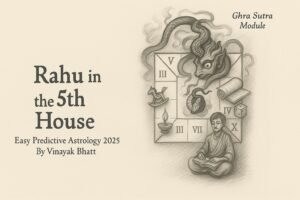
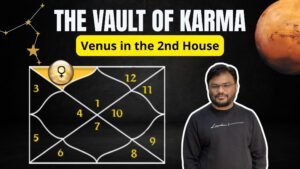
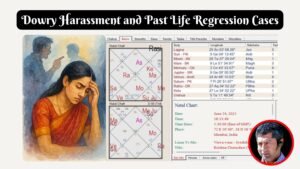



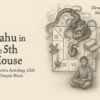

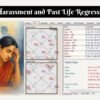
Leave a reply
You must be logged in to post a comment.